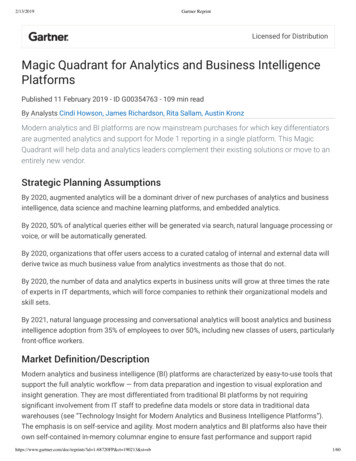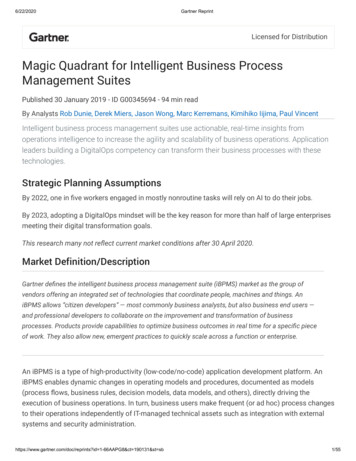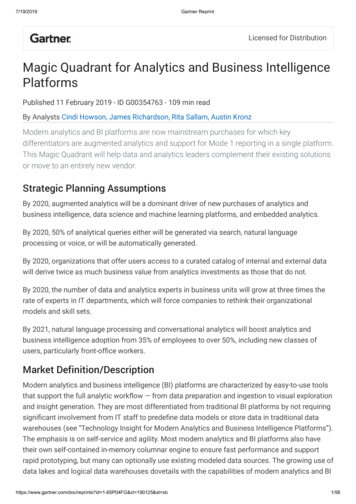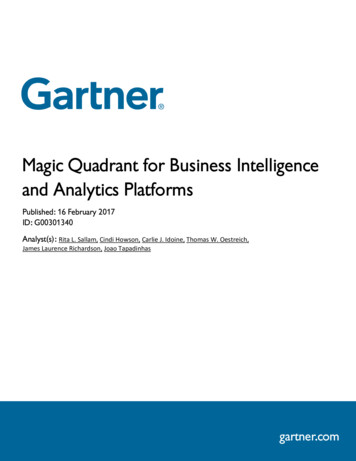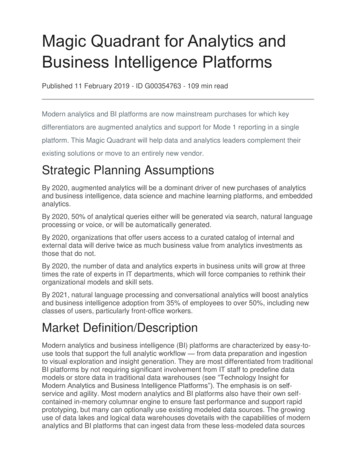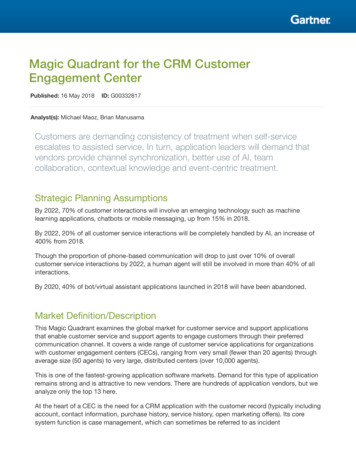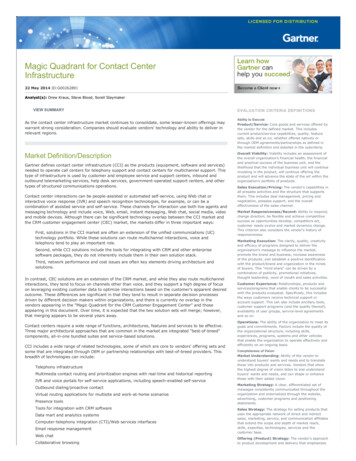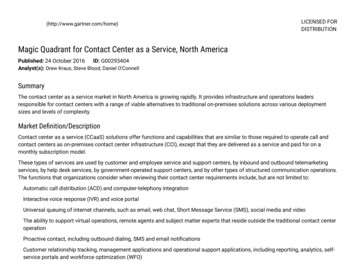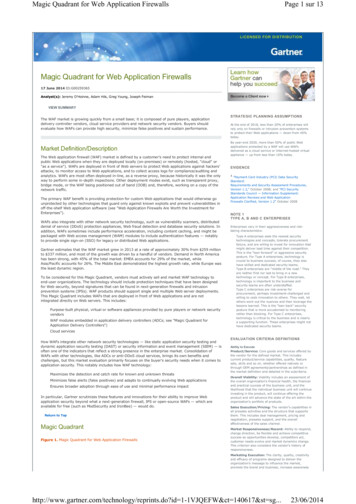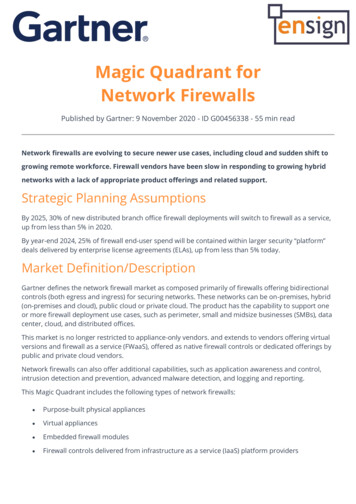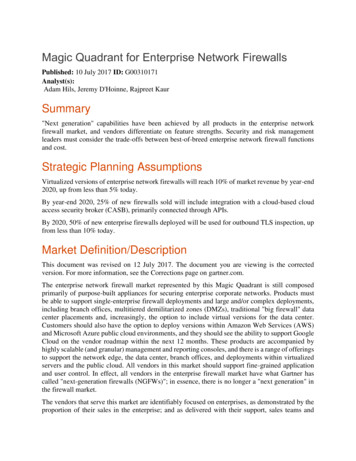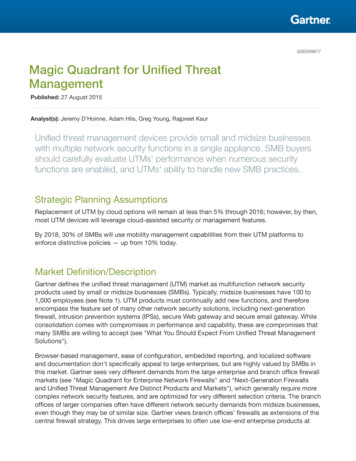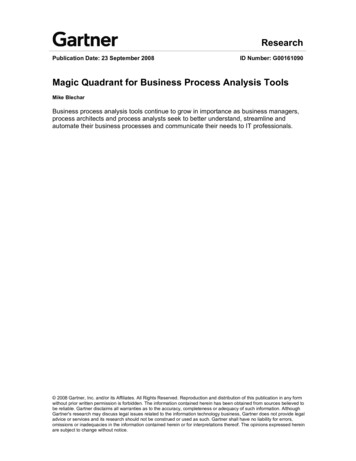
Transcription
ResearchPublication Date: 23 September 2008ID Number: G00161090Magic Quadrant for Business Process Analysis ToolsMike BlecharBusiness process analysis tools continue to grow in importance as business managers,process architects and process analysts seek to better understand, streamline andautomate their business processes and communicate their needs to IT professionals. 2008 Gartner, Inc. and/or its Affiliates. All Rights Reserved. Reproduction and distribution of this publication in any formwithout prior written permission is forbidden. The information contained herein has been obtained from sources believed tobe reliable. Gartner disclaims all warranties as to the accuracy, completeness or adequacy of such information. AlthoughGartner's research may discuss legal issues related to the information technology business, Gartner does not provide legaladvice or services and its research should not be construed or used as such. Gartner shall have no liability for errors,omissions or inadequacies in the information contained herein or for interpretations thereof. The opinions expressed hereinare subject to change without notice.
WHAT YOU NEED TO KNOWBusiness process analysis (BPA) tools are intended primarily for use by business architects andbusiness process (BP) architects, who are responsible for redesigning BPs at a conceptual level,and BP analysts, who redesign processes at a more detailed level and are responsible forcoordinating the implementation of the new processes as part of BPM projects, IT developmentprojects and package purchase acquisitions (see "Role Definition and Organizational Structure:Business Process Improvement"). Although these two roles are being staffed increasingly in enduser business units, in many organizations, IT architects and analysts more commonly fill theseroles.BPA tools also can be used by other roles in the organization — for example, business users anddata, enterprise and technical architects looking to understand BPs in the context of theirdisciplines. The BPA tool market sits in between the enterprise architecture tool market and theBP management suite (BPMS) tool market; not surprisingly, many BPA tools are sold into thesemarkets for modelers with these focus areas. For example, the BPA tool selection teams fromsome organizations want a tool with more of an architectural focus, including support for modelsrelated to organizational, stakeholder and strategy issues. Still other BPA tool selection teamsfocus on solutions that support the integration of BP models with process assembly, and workfloworchestration and optimization technologies. While others focus on selecting BPA tools thatsupport the integration of business processes and IT modeling tools to facilitate applicationdevelopment and package purchase, BPA tools can support a wide spectrum of organizationalroles that have differing degrees of business and technical modeling expertise; these tools are atthe nexus of most collaborative modeling efforts in the enterprise.More specifically, BPA tools enable BP architects to document, analyze and streamline complexprocesses, enabling business areas to become more agile and effective when used with theappropriate method or approach. BP analysts, in turn, redesign BP models and refine them to amore detailed level to ensure that the processes are communicated properly to those who areimplementing them through development, package purchases or applications hosted by partnersor third parties. IT organizations are increasingly seeking to better understand how BPs relate toand are designed and implemented in service-oriented architectures (SOAs). This requireschanges to architecture, analysis and design methods, policies and practices to create goodbusiness, software and data services that are cost-effective and enable the future direction of theenterprise.Organizations also are showing increased interest in having better integration across rolesthrough the use of integrated or best-of-breed suites of tools that support modeling for BP, objectoriented and data/database analyses and design, and requirements management. For example,as a best practice, organizations are defining BPs, events and workflows in BPA tools and arebridging this information into IT modeling tools and BPMSs where more-detailed software anddata service analyses, design and development occurs.BPA tools are key components of BP improvement initiatives and the discipline of BPmanagement (BPM). BPA tools are used by business analysts and architects to construct BPmodels. Process modeling is a key BPM technology when used in a BPMS. In this capacity, BPAtools complement BPMS tools by enabling deeper, multilevel modeling (conceptual, logical andphysical in greater detail and relationship mapping) than the modeling component of a BPMS.When used in conjunction with a BPMS, the BPA tool can be an integrated component of asingle-vendor BPMS, or it can be a best-of-breed BPA tool that bridges into a best-of-breedBPMS. Because the functionality of best-of-breed BPA tools and BPMS modeling tools overlap somuch, both types of products are included in this Magic Quadrant and must be evaluated in thecontext of a BPA use scenario as described in this research. Beyond the scope of this MagicPublication Date: 23 September 2008/ID Number: G00161090 2008 Gartner, Inc. and/or its Affiliates. All Rights Reserved.Page 2 of 27
Quadrant are the issues related to the degree of integration among tools in a BPMS and how theyshare not only models but all types of metadata (see "Evaluating BPMS Metadata ManagementCapabilities").BPA is also becoming a starting point for BPM projects and compliance activities. Linkage to theworkflow assembly and orchestration engines and business activity monitoring (BAM) tools isdriving BPA into the mainstream for BP improvement initiatives. Understanding complex BPs is asignificant challenge. The assistance of a tool with visualization and other features — such assimulation and activity-based costing (ABC) — helps optimize BPs and realize BPM cost and timesavings. BPA tools help define the business architecture portion of the enterprise architecture.Many BPA tools can be used by technical, application and data architects to define the technicaland information architectures. Because most BPA tools have a shared repository for thesemodels, it is possible to do change impact analyses across organizations and roles based on theinterrelationships of their models. Still, BPA tools focus primarily on the business architect, BParchitect and analyst roles.Although most BPA tools are purchased to do BP improvement from a top-down perspective (thatis, with architecture and analysis preceding projects that implement specific BPs as workflows),many customers first implement a BPM tool for the orchestration of processes as workflows (thatis, to improve a human-to-human process), then add a BPA tool to better understand theirprocesses at a more abstracted level of detail. BPA tools enable architects and analysts todiagram their processes using rules or specifications to promote understanding and to validatethis information using standard methodologies and best practices enabled by the software.Ideally, organizations use the knowledge captured in these BPA tools to automate the modelsinto deployable applications that leverage the analytical efforts and ensure compliance of theexecution environment with BP rules. Generally, this is accomplished via bridges from the BPAtools to other BPM or IT development technologies. When round-trip changes are neededbetween BPA and BPM models, buyers typically focus on a more tightly integrated BPMSsolution, normally from a single vendor.What has been the growth rate for the BPA tool market during the past three to four years?Based on Gartner estimates, the market revenue has grown consistently an average of 10% to15% during the past several years. Gartner BPA market estimates for new-product license andmaintenance revenue in 2006 was 404 million, and this grew to an estimated 415 million in2007 (around 10% growth). When sizing the 2006 BPA tool market, we included 5% of the BPMStool market ( 45 million) to account for the BPM tool modeling capabilities being used for BPA.For 2007, we elected to count revenue only from BPMS vendors for BPA tools sold separately. Inother words, the 415 million represents best-of-breed BPA tools, even if some vendors haveother process modeling tool revenue as part of their BPMS. So, in 2007, we excluded some of theBPMS modeling tool revenue we counted in 2006 as part of the BPA tool market. Therefore, theBPA tool market arguably grew at closer to a 15% rate over the past year.A large follow-on market also exists for consulting and services in implementing these tools andthe methods to use them. When calculating the BPA market revenue, we did not includeconsulting or service revenue. For many vendors, this add-on consulting and service revenuesignificantly exceeds software revenue. Also, BPA tool vendors increasingly are addingcomplementary software products in the areas of governance, risk and compliance (GRC), aswell as more-purchasable content in terms of prebuilt models delivered in their BPA tools.What is the projected growth rate for the BPA tool market during the next few years?Expanding the demand for BPA tools should result in at least a 10% compound annual growthrate in market revenue through 2010. We expect that the number of BPA users will grow atsignificantly faster rates than BPA market revenue. This will create greater opportunities forPublication Date: 23 September 2008/ID Number: G00161090 2008 Gartner, Inc. and/or its Affiliates. All Rights Reserved.Page 3 of 27
selling increased BPA consulting services and open up more cross-product marketing to vendorswith multiple tool offerings as part of their BPMSs.Do you expect the BPA market to disappear at some point because of vendorconsolidations and the emergence of BPMSs? If so, then when do you expect this tohappen?We do not see the BPA market disappearing, even in the long term (that is, through at least 2012)— although market consolidation of vendors already has begun (for example, the acquisition ofProforma by Metastorm and Telelogic by IBM). The stability of BPA tool vendors is not based onlyon product sales. Most BPA vendors have a complementary set of consulting service offerings insuch areas as BP methods and disciplines that can generate revenue at five times the BPA toolrevenue rate; therefore, the stability of the BPA tool market — including smaller specialty/nicheBPA vendors — is greater than may appear at first glance.The BPA tool market will continue to attract new players, especially BPM/BPMS vendorsextending their tools to provide greater BPA capabilities, and other vendors, such as those in theobject-oriented analysis and design and data modeling/database design markets extending theirtools to support BPA. Because BPMSs include BPA technology as a key component, manyorganizations will implement an integrated single-vendor solution from their strategic partnersduring the long term. Currently, however, the BPA tool market leadership is dominated by best-ofbreed technologies. Therefore, opportunities will continue for specialty — generally niche — BPAvendors to flourish (see the vendors listed in the Honorable Mention section). For more on theevolutionary path of the BPMS market, see "Four Paths Characterize BPMS Market Evolution."Anther interesting and related dynamic is that the enterprise architecture tool market is extendingincreasingly down into the level of solution architecture, beyond the future enterprise technologyarchitecture and into enterprise data, application and (especially) business architectures.Therefore, many leading BPA tool vendors, especially those that also have enterprisearchitecture tool offerings, can be expected to grow their BPA business "up" into the level ofsolution architecture as part of broader modeling suites. For more on this topic, see "Trends inCollaborative Modeling."At the same time, we expect consolidation in an overcrowded market. Many small players,especially those coming late to the market or failing to address alliance partnerships anddistribution channels, will be bought, fall to niche status or slowly disappear. However, the overallBPA tool adoption rate will accelerate as mainstream organizations become more involved withBP modeling to support SOAs and address compliance issues with models based on governmentmandates and buy and implement the next generation of model-driven application packagesbased on BP models and prebuilt service-oriented software and content. For more information,see "Model-Driven Packaged Applications: Using SOA and BPM to Modernize PackagedApplications."Publication Date: 23 September 2008/ID Number: G00161090 2008 Gartner, Inc. and/or its Affiliates. All Rights Reserved.Page 4 of 27
MAGIC QUADRANTFigure 1. Magic Quadrant for Business Process Analysis ToolsSource: Gartner (September 2008)Market OverviewAs with the 2007 BPA tool Magic Quadrant, we continue in 2008 to focus on BP architects andanalysts as the prototypical buyers of BPA tools. In 2007, we identified three major areas of focusby BPA tool buyers, which we called "architects," "BPMS modelers" and "BP modelers."Architects required robust solutions aligned with enterprise architecture, BPMS modelers focusedon BP modeling as part of BPMS process composition projects and BP modelers focused on BPimprovement projects, regardless of whether there would be a BPMS implementation (that is, toidentify BP improvement opportunities that might involve some or all of application packagepurchases, application development, or enhancement or process composition).In 2008, buyer focus has become more complex (see "Consider Eight Areas of Focus WhenSelecting a Business Process Analysis Tool"). Although we still weight the selection criteria forthis BPA tool Magic Quadrant in favor of vendors with tools whose footprint best supportsbusiness architects, BP architects and BP analysts, we recognize that BPA tool purchases maybe intended to solve the needs of a more diverse user base. These areas of buyer focus are notintended to be descriptions of job positions; they merely reflect how organizations prioritize whowill use the BPA tools and, by extension, how the tools will be used. That is, if enterprisebusiness architects are the prime target users of the tools, then their methods and the functionsand features they need will be different from other users of the BPA tool, such as BP analystsPublication Date: 23 September 2008/ID Number: G00161090 2008 Gartner, Inc. and/or its Affiliates. All Rights Reserved.Page 5 of 27
working on BP automation projects using a BPMS. BPA tools can support a wide spectrum ofroles that have varying degrees of business and technical expertise. Certain tools meet specificneeds better than others, so it is important to prioritize who will use the tool and to understand themethods and functional requirements of tool use to choose the most appropriate product duringthe selection process.Organizations should not consider vendor placement in this BPA tools Magic Quadrant asautomatically reflecting which tools will best match their organizational needs. In some cases, aniche player or a tool mentioned in the Honorable Mention section of this research may be thebest fit.In the companion research "Understanding Vendor Placement in the BPA Tools MagicQuadrant," we explore the issue of which vendors and products best meet users' differing needsand how BPA solutions are compared and contrasted with one another.Honorable MentionA number of interesting alternative vendors didn't make the cut for the BPA Magic Quadrantappear in this section. In some cases, these vendors did not make the cut because they did notreach the minimum revenue required for inclusion (generally due to their newness). Othervendors offer interesting complementary tools. We deemed the following technologies as worthyof honorable mention: Embarcadero EA/Studio: Embarcadero Technologies has a leading datamodeling/database design tool, EA/Studio. The release of a BPA tool, EA/Studio, on 15March 2007, completed Embarcadero's modeling suite, providing BP modelers with alow-cost companion tool that supports the Business Process Modeling Notation (BPMN)standard. The initial release of EA/Studio focuses on ease of use. EA/Studio iscompliant with the Eclipse open-source standard and, therefore, can "plug and play"with any other Eclipse-compliant tool. It lacks some of the more-robust capabilities of theBPA tool market leaders; however, for many organizations, it's a good alternative toMicrosoft's Visio — especially for EA/Studio customers looking to integrate and leveragemodels and requirements across business and data analyst roles. EA/Studio comes intwo editions. EA/Studio Community Edition (CE) can be downloaded for free atEmbarcadero EA/Studio CE. As with most free software, it comes with no help desksupport. However, users can download updates to CE for free, as they becomeavailable. EA/Studio Business Modeler Edition (BME) has more-advanced support forthe BPMN standard and supports conceptual modeling for top-down database design.BME sells for an average seat price of approximately 1,000, which includes help deskand maintenance support. BME comes with a bidirectional bridge with EA/Studio, andCE and BME both have a bridge from Microsoft Visio. Global Enterprise Managers' GEMWorX FlowModeler: Global Enterprise Managers'GEMWorX FlowModeler extends Visio's modeling capabilities (that is, it merely "popsup" in the Visio user interface environment in a transparent way to modelers) with moresupport for business modelers. Visio users will find that, in FlowModeler, their diagramscan be organized hierarchically, linked to each other (and to process-related resources),Web-published and navigated in a browser. Subsequent process design bringsGEMWorX's data-driven functionality into play, including a lightweight learningmanagement system that enables FlowModeler/Visio diagrams to be transformed intobusiness reference and e-learning assets. FlowModeler is part of the GEMWorX Suite ofintegrated BP analysis and e-learning tools. It is repository-based, includes support forversioning and team sharing of model information (that is, integration with MicrosoftOffice SharePoint Server) and simulation (with animation) for ABC. FlowModeler alsoPublication Date: 23 September 2008/ID Number: G00161090 2008 Gartner, Inc. and/or its Affiliates. All Rights Reserved.Page 6 of 27
allows user-defined process shapes with custom attributes, includes preformattedreports, readily enables users to query the data repository and provides flexible searchcapabilities (via Workflow Explorer) that support the maintenance and updating ofprocess diagrams. GEMWorX is focused on human-driven processes, so it emphasizessimplicity and clarity for the (Visio) modeler and the (Web-based) end user. AlthoughGlobal Enterprise Managers is a small, emerging company, the potential value ofGEMWorX can be high. Organizations that must produce end-user learning materials incoordination with model-based new development, package acquisition and BPimprovement projects — including by large external service providers (consulting) andERP (application package) vendors — will find GEMWorX worth considering, as willthose expecting high levels of personnel turnover requiring training of new employees.Stand-alone, single-user FlowModeler is 295. However, most purchases ofFlowModeler generally are made as part of a GEMWorX Suite acquisition. A typicalGEMWorX Suite implementation includes 10 FlowModeler seats and 20 concurrenteUser logins in the price range of from 16,000 for an annual subscription to 36,000 fora perpetual license. Additional FlowModeler users are 700 per seat, and blocks ofconcurrent eUser logins are
single-vendor BPMS, or it can be a best-of-breed BPA tool that bridges into a best-of-breed BPMS. Because the functionality of best-of-breed BPA tools and BPMS modeling tools overlap so much, both types of products are included in this Magic Quadrant and must be evaluated in the context of a BPA use scenario as described in this research.
